How To Get Rid Of Bees And Wasps
It's a It's a perfect summer day and you're sitting outside with your family grilling something delicious for dinner. Right then you hear it, a menacing buzz just over your shoulder. The wasps have arrived, and they're not leaving. They drive you indoors, ruining your perfect afternoon.
Sounds familiar? You're not alone.
Each year, wasps take over outdoor spaces throughout the country, including the San Francisco Bay Area, making them difficult or impossible for people to use.
Plus, wasps can be dangerous.
According to the Centers for Disease Control and Prevention (CDC), there were 1,109 deaths from hornet, wasp, and bee stings between 2000–2017, or an annual average of 62 deaths.
Fortunately, you don't have to resolve yourself to living with stinging wasps all summer. Smith's Pests Management is here to help you reclaim your property.
We provide yellow jacket control services to customers in and around the San Francisco Bay Area, so we know a thing or two about how to help people get rid of wasps and start enjoying the outdoors once more.
In this blog, we'll share a few of our top wasp removal tips and tricks, and insights on identifying common wasp species.
Let's dive in.
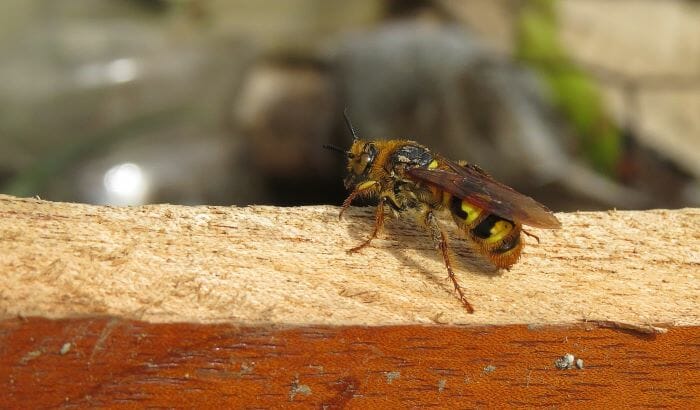
What Kind of Wasps Do I Have?
Wasps and their cousins, hornets and yellowjackets have nasty stings that can be especially dangerous to anyone allergic to them.
Even if you're not allergic to wasps, they can be a danger to anyone who gets too close to their nest. They will come boiling out, often in large numbers, and immediately sting any person or pet who is nearby.
While some wasp species are highly aggressive, others are more docile. Some species, like mud daubers, kill and eat other pest species, like spiders.
Since they help keep pest populations down, people can usually coexist with mud daubers (as long as they're in an out-of-the-way place where people and pets will not disturb them).
Because wasps behave so differently, you have to identify what kind of wasps you have before you can start dealing with them.
With that in mind, here's a breakdown of the most common wasp varieties: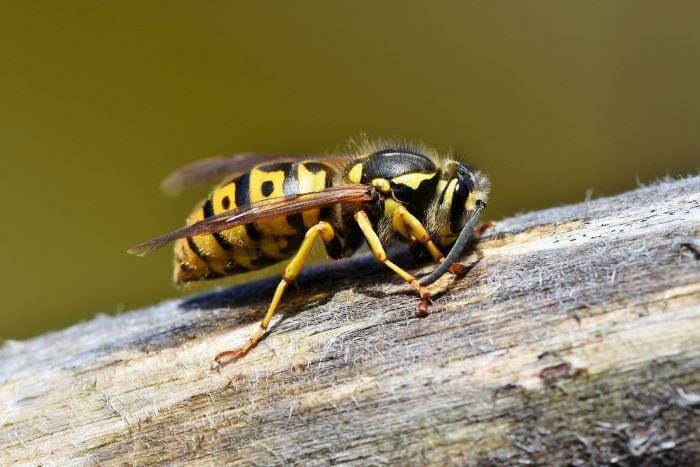
Yellow Jackets
Yellow jackets are bee-sized wasps known for their distinct black and yellow markings. They are common throughout the world and particularly abundant in the southeastern US.
Adults grow to about ⅜" to ⅝." They live in colonies and build nests inside structures or on the ground to protect the group.
Paper Wasps
At ¾" to 1" long, paper wasps are slightly larger than yellow jackets. Their bodies are brown or black, with yellow to red markings.
They live throughout North America, and usually build their nests near the shelter of buildings. Their nests are small and only include a single layer of comb for brood rearing.
Like other wasp species, they will not sting unless they feel threatened. While yellow jackets are black and yellow, paper wasps are brown and yellow.
Hornets
There are about 20 species of hornets in the world. The varieties in California typically grow to about 1.25." They tend to be black, with light yellow or white stripes that are more distinct than those found on a yellow jacket.
Hornets build hives by chewing wood into a papery pulp and using it to construct walls. Most nests are built on high trees or sturdy, woody plants.
These wasps are highly social, and generally will not sting unless they are threatened or provoked. When they are threatened, they swarm.
Mud Daubers
Mud daubers typically grow to ½" to 1" long. They are black, with bright yellow markings on their thorax and legs, and a long, thin body that sets them apart from other wasp species.
While they're native to North America, they can be found throughout the world. Unlike the other wasps on this list, they do not live in colonies or build nests with other wasps.
Instead, mud daubers use mud to build small nests for themselves and their offspring. They are a generally docile species and do not swarm like other wasps.
Bees vs. Wasps
While people often confuse honeybees and wasps, they are not the same creatures. While wasps are a pest species, honeybees are a keystone species that are critical to the environment.
Honeybees are a critically important species andwe do not recommend removing them from your yard or property.
Fortunately, there are a couple of ways to tell wasps and bees apart.
For example, bees are not aggressive, and can only sting once before dying. Wasps, on the other hand, can sting multiple times. Honeybees also have larger bodies and a light coating of downy hair. While both wasps and bees pollinate plants, honeybees are much more active pollinators than wasps.
What Attracts Wasps to My Yard?
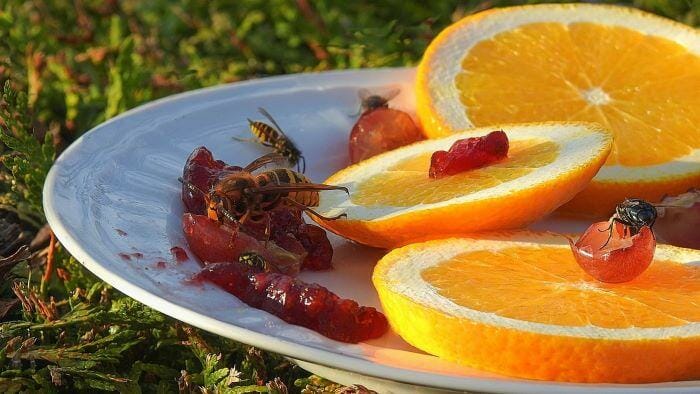
If you have wasps in your yard, you're probably wondering why they've chosen to pester you.
Here's the truth:
While wasps migrate through virtually every yard from time to time, the following things attract them and entice them to stay:
1. Shelter
In the fall, male wasps die after impregnating the colony's queen. The queen wasps then take shelter in safe, warm, protected places where they survive the winter.
Wasps may be hanging out in your yard because they've found safe refuge there. Things like insulated walls, crevices, and cracks shelter wasps from potential predators and harsh elements.
2. Food sources
After hibernating all winter long, the queen and her workers emerge in preparation for the summer months. And after a long winter, they're hungry and looking for food sources. If they can find something to eat in your yard or garden, they'll stay.
Some wasps, known as digger wasps, will hover above the ground to prey on larvae, grubs, and other insects. Because of this, one of the best ways to prevent a wasp infestation on your property is to get rid of other pest species like spiders first.
3. Food leftovers
While wasps hunt for some of their food, they also love a free meal when they can find it. They eat protein-based foods, and will scavenge leftovers like meat scraps or grill drippings. While you can't keep wasps from noticing your cookout altogether, you can discourage them from staying by covering your cooked food and cleaning up spills promptly.
4. Sugar
When fall comes around, wasps start searching for sources of sugar to get them through the winter. Wasps will seek out fallen fruit from trees, soda cans, hummingbird feed, fruit juice, and anything else that is a good source of sucrose.
5. Flowers
Wasps are attracted to flowering plants. They enjoy the nectar of the flowers and the fragrance, and can quickly take over a garden bed. If you wear strong perfume, they may also be attracted to that scent.
How to Get Rid of Wasps in Your Yard & House
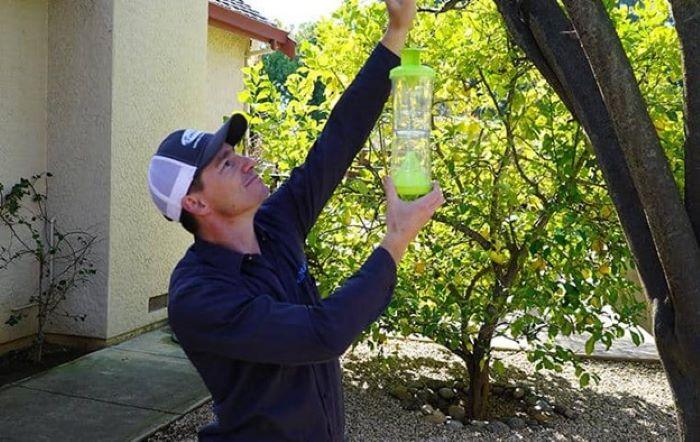
Whether you're allergic to wasp stings or you simply want to send the winged pests packing, we have some effective tips to help you get rid of wasps both indoors and outside. These tips apply to all wasps, including yellow jackets and hornets.
7 Ways to Get Rid of WaspsIn Your Yard
If you have wasps in your yard, these tips can help you get rid of them:
1. Hang wasp traps
Wasp traps are one of the most common—and effective—ways to get rid of wasps in your yard. The traps feature a liquid that attracts wasps. When the wasps crawl into the trap, they get stuck and drown. While wasp traps are effective, they accumulate dead wasps and can be unsightly to look at. Replace them often and be sure to hang them away from your outdoor living areas.
2. Spray wasp nests
If you see an active wasp nest around your home or property, spray it with store-bought wasp nest spray. For best results, wear protective clothing and spray the nest late in the evening, when the wasps are dormant, and the workers and queen are all present. Purchase a wasp spray with a nozzle that allows you to spray from a distance. Re-spray the nest repeatedly over the course of a few days, if needed.
3. Use soap and water
If you want an alternative to store-bought insecticides, tackle small wasp nests with soap and water. Mix two tablespoons of dish soap into a spray bottle of water and spray it on the nests. The mixture will clog the wasps' breathing pores and kill them instantly.
4. Create homemade traps
Build a homemade wasp trap by cutting the top off a large soda bottle and adding a few inches of soda or fruit juice (with a few drops of dish liquid) to the bottom. Invert and replace the top and hang the homemade trap in your yard.
5. Kill emerging wasps
Store-bought wasp killing sprays can be effective for eliminating individual wasps. Spray wasps as you see them, being sure to follow all label directions on the insecticide you buy.
6. Treat future nesting areas
In addition to sprayingexisting nests, you can treat future nesting areas. Purchase residual liquid insecticides at your local home or hardware store and spray it in the areas where you think wasps would nest, such as your deck, pool, patio, playset, and wood fence. This discourages future nest building.
7. Call a professional
Getting rid of large outdoor wasp colonies can be impossible to DIY. For fast, professional results, contact Smith's Pest Management. Our team will remove existing wasps and take steps to prevent new colonies from forming.
How to Get Rid of WaspsIn the House
Wasps indoors can be a major problem. Here are a few tips to get rid of them:
1. Check every entry point
Unless you're leaving your doors and windows open without a screen, wasps are likely entering your home through a tiny gap somewhere. If you've noticed wasps indoors, examine your eaves, the mortar between your bricks, the beams and supports in your garage, and the areas around your home's vents. Wasps tend to build their nests in these areas, and can easily exploit even a tiny crack to enter your home. Once you find their access points, seal any cracks or gaps with silicone caulk.
2. Try effective home remedies
If you're looking for a natural way to get rid of wasps, there are plenty of home remedies to choose from. One excellent way to get rid of wasps is with vinegar. To create a homemade wasp repellent, mix two cups of apple cider vinegar, two cups of sugar, and one cup of water. Stir the mixture thoroughly and place it near the nest where it will attract and kill wasps.
3. Spray wasp nests
What kills wasps instantly? Wasp spray. Still, we advise caution when using wasp spray indoors. While insecticide is effective, it contains chemicals that can be very dangerous for children, pets, and people. If the nest is in a seldom-used part of your home, spraying it may be a decent option. If not, you're better off calling a pest management professional.
4. Call a professional
Dealing with an indoor wasp problem can be dangerous and time-consuming. If your wasp problem is extensive, contact a pest management professional to help you. Smith's Pest Management can remove indoor wasps and help you reclaim your safe wasp-free home.
How to Get Rid of Wasp Nests
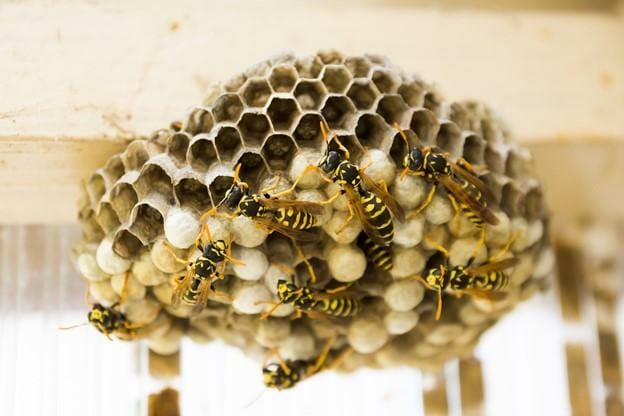
Getting rid of wasp nests seems like a simple job, but it can be complex, since aggravated wasps will swarm and sting.
To keep yourself safe and guarantee good results, always spray the nest with store-bought wasp killer at least 24 hours before trying to remove it. If you still see wasp activity, spray the nest again.
Once the nest looks quiet, follow these tips:
- Approach the nest in the evening hours once you're sure all the wasps inside it are dead
- Use a garbage bag to cover the nest
- Gently pull the nest from the tree or wall it's attached to, and seal the bag around it
- Throw the garbage bag and the nest away in an outdoor trash can with a tight-fitting lid
If the nest is in a hard-to-reach area, don't try to remove it yourself. Instead, contact Smith's Pest Management to remove the nest safely for you.
How do Pest Control Experts Get Rid of Wasps?
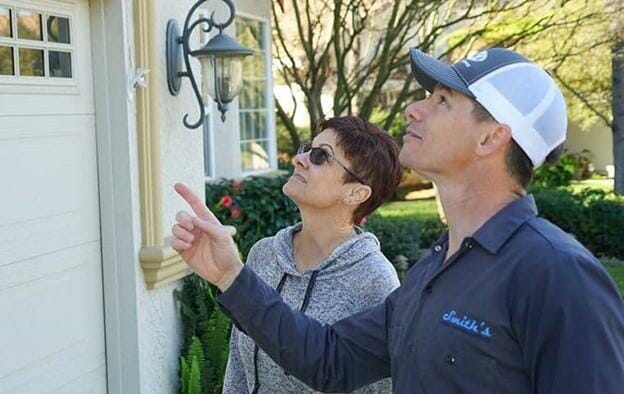
What happens when you contact a professional wasp control expert? Here's the process the team here at Smith's follow to get rid of wasps:
1. Property Inspection
First, we'll locate the wasp nests on your property. Our licensed pest control techs will identify ground or hanging nests and determine the best way to remove all the wasps that live within them.
If you have multiple kinds of wasps on your property, we'll identify each species and create a customized treatment plan to address them.
2. Destroy Wasp Nests
Once we've located the wasps on your property, we'll treat the nests with a substance designed to eliminate the wasps inside their nests. We always use the utmost caution with pest-control substances, and make sure to use every product according to label directions.
3. Apply Additional Yellow Jacket Treatments
Finally, we'll apply treated bait around your property. This important step allows us to eliminate wasps that were not in the nest during the time of treatment. When yellow jackets eat the bait, it kills them quickly without putting your property, pets, or kids at risk.
4. Annual Yellow Jacket Control
If you have severe yellow jacket problems, we'll recommend an annual yellow jacket control program. This solution includes the installation of bait stations, unlimited hive treatments, and year-round protection against these aggressive pests. The result is a pest-free property that you can enjoy all year long.
How to Keep Wasps Away
Wondering how to keep wasps from building nests on your property? Follow these tips:
- Remove food sources. Get rid of all fallen fruit and berries from around outdoor fruit trees, clean up food scraps rapidly, hang hummingbird feeders at a distance from your home, and avoid leaving pet food outdoors. Seal all outdoor garbage cans tightly and cover compost piles. Remember that wasps aren't picky about their food sources, and they'll eat both protein-rich and sugary foods.
- Seal all doors and windows (or install screens). Use caulk to fill small gaps or crevices around your property to prevent wasps from entering your home. If you have screens on your windows and doors, make sure that they're in good repair, since wasps can fit their bodies through even miniscule holes.
- Use wasp-repellent plants. Instead of planting flowers around your porch, plant wasp-deterrent plants like pennyroyal, marigold, wormwood, mint, basil, and geranium.
- Stay vigilant about nests. It's impossible to remove wasps entirely, so you have to stay vigilant about nest formation. Each spring, check your wall cavities, sheds, and garages for signs of new nests. As soon as you notice them, treat them with store-bought insecticide spray and remove the nest shell.
- Cover or treat holes. If you notice large or small holes in cement or grass, fill them quickly. Solitary wasps will look for open cavities in which to make their homes.
- Use natural remedies. Use herbs and essential oils to deter wasps. A combination of clove, lemongrass and geranium essential oils is ideal for applying to outdoor walls, crevices, or other places you've noticed wasp activity. Peppermint oil is also an effective wasp repellent.
Are Wasps Invading Your San Francisco Bay Area Property? We're Here to Help!
Here at Smith's Pest Management, we help residential and commercial properties in Northern California, from Marin to Monterey, get rid of wasps every day.
Let us help you enjoy a wasp-free outdoor space this summer.
Contact us today to schedule your wasp removal service.
How To Get Rid Of Bees And Wasps
Source: https://smithspestmanagement.com/blog/post/how-to-get-rid-of-wasps/
Posted by: spencehativered.blogspot.com

0 Response to "How To Get Rid Of Bees And Wasps"
Post a Comment